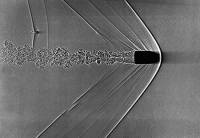MA8103 Non-Linear Hyperbolic Conservation Laws
Spring term 2024
Lecture times:
Mondays 13:15-15:00 in EL23
Wednesdays 10:15-12:00 in F404 (except in week 5, where we have to be in B23)
We start on Mon 22 Jan at 13:15.
General information
Background: In the course we study a class of nonlinear partial differential equation called hyperbolic conservation laws. These equations are fundamental in our understanding of continuum mechanical systems, and can be used to describe mass, momentum and enery conservation in mechanical systems. Examples of the use of conservation laws you may have seen in TMA4305 Partial differential equations and TMA4195 Mathematical modeling as well as in courses in physics and fluid mechanics. The equations share many properties that make numerical computations difficult. The equations may, for instance, develop singularities in finite time from smooth initial data. These equations have been extensively studied due to their importance in applications. Examples of applications include weather forecasting, flow of oil in a petroleum reservoir, waves breaking at a shore, and in gas dynamics.
Lecturer: Helge Holden, Harald Hanche-Olsen
Textbook: H. Holden and N. H. Risebro: Front Tracking for Hyperbolic Conservation Laws, Springer, Second edition 2015. The book exists as an eBook, and NTNU students can read and download it free of charge. You can purchase a paperback edition called MyCopy for € 39.99 (incl. shipping). See the upper right on the linked page. (If you don't see it at that price, perhaps you need to be on the campus network, either physically or via VPN.)
Lectures
| Week | Date | pages | Etc | |
|---|---|---|---|---|
| 4 | Mon | 22.01 | Ch. 1, p. 1–9 | |
| Wed | 24.01 | Ch. 1, p. 9–12, Ch. 2, p. 53–55 | Please do the rest of Example 1.6 and Exercises 1.8 and 1.9 | |
| 5 | Mon | 29.01 | (Harald lectured) Ch. 2, p. 55–59 | Suggest you work through the bottom half of page 59 on your own. |
| Wed | 31.01 | Ch. 2, Sec. 2.2 (p. 60-66) | In room B23! | |
| 6 | Mon | 05.02 | Ch. 2, Sec. 2.3 (p. 66-73) | We stated, but did not prove Corollary 2.8 |
| Wed | 07.02 | Ch. 2, proof of Cor. 2.8, Sec. 2.4, p. 74-78 | ||
| 7 | Mon | 12.02 | Ch. 2, Sec. 2.4, start with (2.61) | We covered the rest of the proof of Prop. 2.10, and the case of convex fluxes for Lemma 2.11 |
| Wed | 14.02 | We proved the rest of Lemma 2.11, and Thms. 2.14 and 2.15 | We did not show the proof of Lemma 2.13 | |
| 8 | Mon | 19.02 | We proved the TVD property (Thm. 2.15) by first studying total variation (App. A, pp. 427-429). Then we started on Ch.3, covering pp. 95-98. We gave the definition of the Lax-Friedrichs scheme | |
| Wed | 21.02 | (Harald lectures this day plus week 9) Started on p. 99, defining the Godunov scheme. Covered consistency and monotonicity (for the latter, see bottom of p. 107) and argued that the Godunov and Lax–Friedrichs methods are both consistent and monotone. Finally, started on the local truncation error. | Skipped most of p. 100–103 (higher order, multistep methods). | |
| 9 | Mon | 26.02 | p. 104–108, also Theorem 3.10 on p. 115, skipping its proof starting near the top of p. 112. | |
| Wed | 28.02 | p. 109–110 [middle of the page), but with quite different proofs based on the Kolmogorov–Riesz compactness theorem and the Arzelá–Ascoli thoerem. (Back to Helge next week.) | See our paper on Kolmogorov–Riesz (arXiv/published version) and Notes on total boundedness and Arzelà–Ascoli |
|
| 10 | Mon | 04.03 | Theorem 3.9 proved, Theorem 3.10 mentioned, but not proved. Ch. 4, p. 171-174. | |
| Wed | 06.03 | Ch. 4, p. 174-180. | ||
| 11 | Mon | 11.03 | (Harald lectures until Easter) Ch. 5 (The Riemann Problem for Systems), p. 223–235, except the \(\epsilon\)-parametrization starting at the bottom of p. 231 (we'll get to that) and the discussion of contact discontinuities (degenerate waves) on p. 232. | |
| Wed | 13.03 | No lecture | ||
| 12 | Mon | 18.03 | Ch. 5, p. 232 (contact discontinuities), 235–240 except the Hugoniot locus for the shallow water equation. Major departure from the book: Get the local \(j\)-shock curve by solving \(u(\epsilon)-u_L=\epsilon v_j(u(\epsilon),u_L)\) for \(u(\epsilon)\) with the aid of the implicit function theorem. | Note: Better approach for the local Hugoniot locus. I also included a few words on the smooth variation of eigenvalues and -vectors, since I was a but unclear in the lecture. |
| Wed | 20.03 | Ch. 5 (cont'd.): The Hugoniot locus for the shallow water equations, including energy/entropy considerations. pp. 241–243, plus the parts from 235–240 skipped on Monday. | Notes: Rankine–Hugoniot for shallow water (new version uploaded 2024-03-22) and Energy for shallow water (new) |
|
| 13–14 | Mon Wed Mon | 25.03 27.03 1.04 | Easter (no lecture) | |
| 14 | Wed | 03.04 | Uncertainty quantification for conservation laws | pp. 239–244 Uncertainty quantification for conservation laws |
| 15 | Mon | 08.04 | pp. 245–247, 256 (Lemma 5.20)–259 | |
| Wed | 10.04 | pp. 259–262 | ||
| 16 | Mon | 15.04 | (Harald lectures.) Ch. 5 (cont'd.) I'll update soon, sorry for the delay. | |
| Wed | 17.04 | |||
| 17 | Mon | 22.04 | Equivalence of the Eulerian and Lagrangian viewpoints | Note on Eulerian vs Lagrangian |
| Wed | 24.04 | Case study: The Euler equations | Note on the Saint-Venant and Euler equations | |
| 18 | Mon | 29.04 | (Helge is expected back. Final lecture) | |


